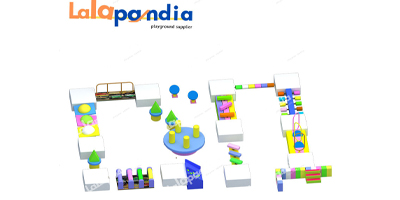2024.11.26
Posted By: Peter
Step into the world of children's obstacle courses, focus on venue protection, and start exploring a safe adventure.

I. Ground Protection: Cushioning the Impact of Falls
Areas with Rubber Mats Laid: In the core activity areas of the children's obstacle course, such as right below the climbing frames and jumping points, high-quality rubber mats are laid. The thickness of these mats ranges from 8 to 10 centimeters, and they possess excellent shock-absorbing properties. When a child falls from a height of 1 to 2 meters, the rubber mats can absorb approximately 70% of the impact force, effectively reducing physical injuries.
Combination of Sand and Rubber: For areas like long jump sand pits and simulated ditch-crossing areas, a combination of sand and rubber mats is adopted. The depth of the sand is 30 to 40 centimeters. When a child lands in it, the sand can first disperse part of the force, and then the rubber mats will further cushion the impact, providing double protection to reduce the risk of injury.
II. Peripheral Protection: Preventing Accidental Slips
Key Points of Guardrail Installation: Along the boundaries of the Children's Obstacle course, metal guardrail posts are set up every 2 to 3 meters. The total height of the guardrails is 60 to 80 centimeters, with 2 to 3 horizontal bars. They are made of anti-corrosion aluminum alloy materials, and the surfaces have anti-slip textures. This not only prevents children from climbing over but also reduces abrasions in case of collisions.
Details of Safety Net Provision: Around facilities such as rope bridges and high-altitude balance beams, high-strength nylon safety nets are installed. The mesh size is about 5 to 8 centimeters to avoid children's limbs getting stuck. The safety nets are connected to sturdy ground bases or surrounding structures through stainless steel hooks, with a spacing of no more than 50 centimeters to ensure stability and reliability.
III. Protection at Dangerous Points Strengthening the Safety of Key Areas
Protection for Climbing High Walls: In the area of climbing high walls, anti-collision pads are laid within 1 to 2 meters below and around the wall. The anti-collision pads are filled with high-density polyurethane foam, which can withstand an impact force of 100 to 150 kilograms. The outer layer is wrapped with wear-resistant and easy-to-clean artificial leather to reduce the degree of injury in case a child falls.
Warnings in Narrow Passages: In narrow passages and areas with rotating obstacles, brightly colored warning signs are posted at a height level with children's line of sight, which is about 40 to 60 centimeters. Meanwhile, the edges of the passages and the corners of the obstacles are wrapped with 3 to 5 centimeters thick soft rubber protective strips to prevent collisions and injuries.